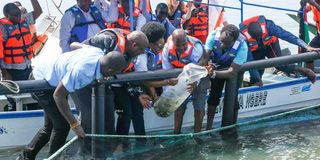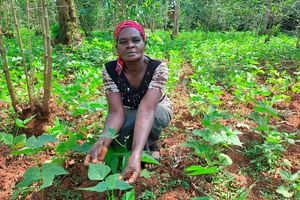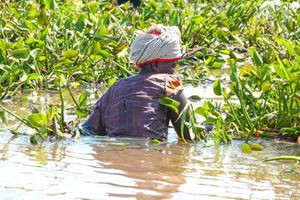
Silpah Owich (centre), Head of Women and Youth Banking at Equity Bank and Kisumu Deputy Governor Mathew Owili (second right) place fingerlings in a cage at Ogal Beach during the launch of the AquaFedha credit solution on March 25.
More than 150 small and medium-sized fish farmers from 10 counties are beneficiaries of a new credit financing solution.
The counties are Kisumu, Kakamega, Siaya, Homa Bay, Migori, Kirinyaga, Busia, Vihiga, Nyamira and Kisii.
Aquarech, a fish farming platform, has partnered with financial institutions to give credit to small and medium-sized farmers to acquire quality inputs and production equipment for increasing fish harvests.
The Sh100 million programme dubbed AquaFedha, is Kenya’s first fish farming platform coming at a time fish farmers are grappling with high costs of production, including building cages, ponds and buying feed.
Aquarech Ltd Chief Executive Officer, Dave Oketch, said through the financing solution, small and medium-sized fish farmers can easily increase productivity and profits.
“We are looking at a product that is helping the farmers move from peasant to commercial aquaculture. We enable the fish farmers transition from 300 metre square metallic cages with 800 fingerlings stocking density to circular 15 diameter high density plastic cages with 60,000 fingerlings stocking density,” Oketch said.
Many farmers need quality inputs and production equipment but have no access to credit.
The solution enables the fish farmers to access bank loans guaranteed by Aquarech Ltd.
“Aquarech plans to scale AquaFedha to reach 15,000 fish farmers across Kenya in the coming two years, with intention to expand into the rest of East Africa. This will increase fish production in Kenya by 50 per cent,” Oketch said during the launch of the financing solution at Ogal Beach in Kisumu, which has 60 cage farmers.
Ogal Beach produces two to four tonnes of tilapia from cages daily, with the potential to expand production.
Equity Bank Director of Youth and Women Banking, Silpah Owitch, said the financial institution would support purchases of boat engines, hatcheries, cages and supply fingerlings.
“We want to ensure Kenya is self-sufficient. We do not have to import fish from as far away as China. The aim of the programme is also to increase fish consumption in Kenya from for kilo per person per year to at least 20 kilogrames,” she said.
Uganda’s consumption stands at 14 kilos of fish per person per year, China at 34 kilogrammes while the global figure is 21.
Equity Bank Manager Blue Economy Manager, Patrick Nyoike, said the model being explored is a value chain approach where farmers are supported through inputs, production and marketing.
“We bring farmers together to address the challenges faced in the entire value chain. We want a scenario where a fish farmer can walk into our banks and get financing for his or her venture,” Nyoike said.
Kisumu Deputy Governor Mathew Owili described the programme a bold step that would address financial challenges in the fish value chain.
The deputy county boss added that the launch was the beginning of a transformative journey, “and with collective effort, we can position Kisumu as a fisheries and Blue Economy hub”.
“This will increase fish supply for and empower local farmers through sustainable aquaculture. The fish sector remains a driver of growth in Kisumu County,” he said.
“Through strategic investments in value-addition, production and supply chain improvements and innovative fishing technology, we can unlock untapped opportunities.”
He added that by fostering partnerships, cooperatives and networks, the devolved government aims to connect fish farmers to better markets, ensuring their voices are heard and their produce is value-added for maximum benefits.
Despite its potential, fisheries faces many challenges, including declining stocks due to overfishing, habitat destruction and environmental degradation.
The depletion of natural fish stocks has hit economic returns and heightened hunger in communities around the lake.
“Cage culture is a viable and sustainable alternative, offering a controlled environment for farming that reduces pressure on wild stocks while increasing production,” the deputy governor said.






